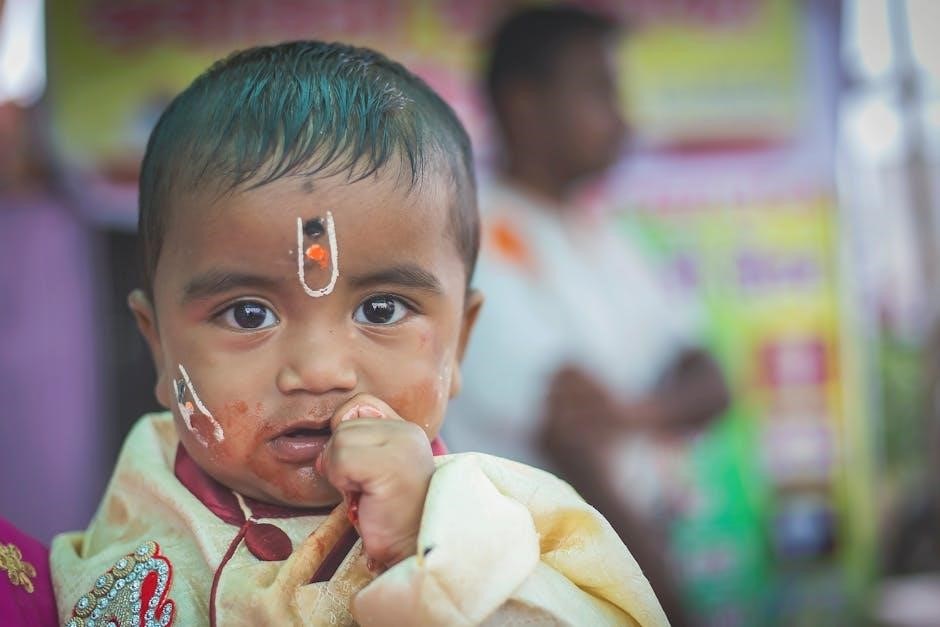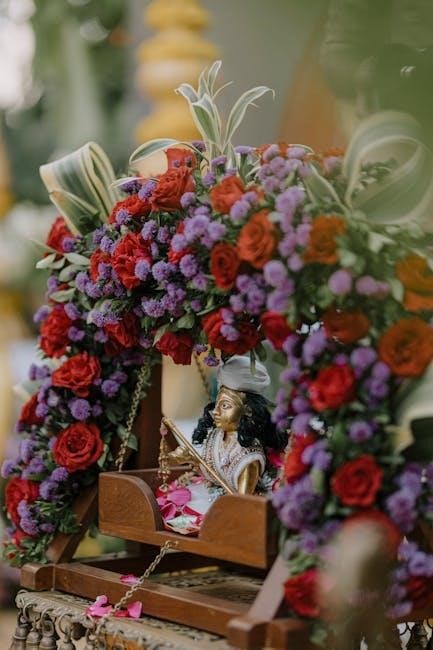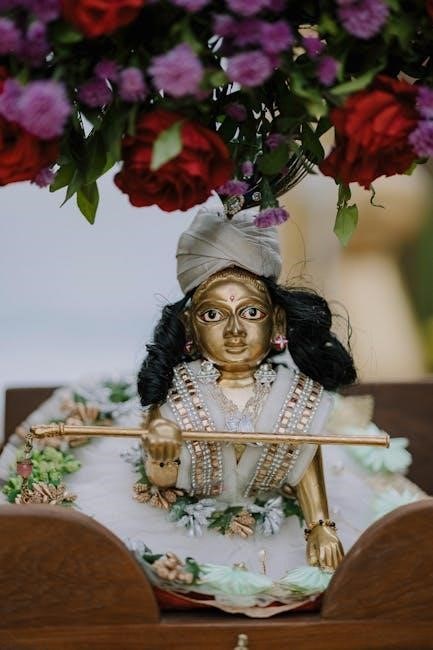
Kirtan Sohila is a sacred Sikh evening prayer, consisting of five hymns from Guru Granth Sahib; It reflects themes of divine praise, devotion, and self-purification, offering spiritual solace and inner peace․
What is Kirtan Sohila?
Kirtan Sohila is a sacred Sikh prayer sung in the evening, comprising five hymns from the Guru Granth Sahib․ It is a heartfelt expression of devotion, praising the divine and reflecting on self-purification․ The hymns, written by Sikh Gurus, emphasize the importance of meditation, divine love, and the transformative power of faith․ Recited before sleep, Kirtan Sohila helps seekers connect with the divine, fostering inner peace and gratitude․ Its serene melody and profound teachings make it a cornerstone of Sikh spiritual practice, offering solace and guidance for daily life․ The prayer is also part of the daily Nitnem (Sikh prayers) and is widely accessible in digital formats for modern convenience․
Significance of Kirtan Sohila in Sikhism
Kirtan Sohila holds profound significance in Sikhism as an evening prayer that fosters spiritual reflection and divine connection․ It is recited to seek blessings, express gratitude, and attain inner peace․ The prayer emphasizes devotion, self-purification, and the importance of Guru’s teachings․ By singing these hymns, Sikhs reflect on their actions, seeking forgiveness and guidance․ Kirtan Sohila also serves as a reminder of the divine’s presence in all aspects of life, encouraging mindfulness and humility․ Its recitation is a cherished tradition, offering solace and strength to believers while reinforcing the core values of Sikh spirituality․ This sacred practice is integral to daily worship, enriching the lives of Sikhs worldwide․
The Structure and Composition of Kirtan Sohila
Kirtan Sohila comprises five hymns from Guru Granth Sahib, spanning Ang 12 to Ang 13, written by Guru Nanak Dev Ji, Guru Ram Das Ji, and Guru Arjan Dev Ji․
The Five Hymns and Their Sources
Kirtan Sohila is composed of five hymns sourced from the Guru Granth Sahib․ The first hymn, written by Guru Nanak Dev Ji, focuses on the soul’s union with the divine․ The second and third hymns, also by Guru Nanak, emphasize devotion and divine praise․ The fourth hymn, by Guru Ram Das Ji, reflects on divine mercy and spiritual longing․ The fifth hymn, attributed to Guru Arjan Dev Ji, highlights the transformative power of divine love․ These hymns collectively convey themes of devotion, self-purification, and the pursuit of spiritual harmony, drawing from the teachings of the Sikh Gurus․
Key Themes and Messages in the Hymns
The hymns of Kirtan Sohila revolve around themes of divine praise, self-reflection, and spiritual growth․ They emphasize the importance of devotion, love, and surrender to the divine․ The hymns also highlight the transformative power of meditation and prayer, urging believers to seek inner peace and harmony․ Messages of compassion, humility, and service to humanity are intricately woven into the verses․ The hymns inspire a deep connection with the divine, encouraging followers to embrace a life of virtue and mindfulness․ Through these teachings, Kirtan Sohila serves as a guide for spiritual enlightenment and moral living, resonating with the core principles of Sikh philosophy․
Historical Background and Evolution

Kirtan Sohila originated from Guru Nanak Dev Ji and evolved through subsequent Sikh Gurus, blending divine hymns into a unified prayer, later documented for preservation and practice․
Origins and Development of Kirtan Sohila
Kirtan Sohila traces its origins to Guru Nanak Dev Ji, who composed the initial hymns․ Over time, subsequent Sikh Gurus contributed to its development, refining it into a sacred prayer․ The hymns were initially sung in congregations before being documented, ensuring their preservation for future generations․ This prayer became integral to Sikh devotion, encapsulating themes of divine praise and self-reflection․ Its evolution reflects the collective spiritual wisdom of the Sikh Gurus, blending their teachings into a cohesive and meaningful prayer․ Today, Kirtan Sohila remains a cornerstone of Sikh practice, offering spiritual guidance and solace to adherents worldwide․

The Role of Sikh Gurus in Shaping the Prayer
The Sikh Gurus played a pivotal role in shaping Kirtan Sohila, contributing their divine wisdom and spiritual insights․ Guru Nanak Dev Ji laid the foundation with his compositions, while subsequent Gurus expanded the prayer, infusing it with deeper theological meanings․ Guru Arjan Dev Ji, in particular, finalized its structure, ensuring its lyrical and spiritual harmony․ Each Guru’s contributions reflected their unique experiences and teachings, creating a prayer that resonates universally․ Their collective efforts transformed Kirtan Sohila into a powerful tool for spiritual growth, emphasizing devotion, self-purification, and the pursuit of divine union․ The Gurus’ involvement not only sanctified the prayer but also ensured its relevance across generations․

Spiritual and Emotional Benefits
Kirtan Sohila fosters a deep sense of divine connection, offering emotional comfort and inner peace․ Its recitation nurtures spiritual growth, calming the mind and uplifting the soul․

Themes of Divine Praise and Devotion
Kirtan Sohila beautifully encapsulates themes of divine praise and unwavering devotion․ The hymns glorify the Creator, emphasizing the joy of spiritual union and the transformative power of love․ Through heartfelt melodies, the prayers express gratitude for divine blessings and reflect on the soul’s longing to merge with the Eternal․ They also highlight the importance of meditation and remembrance of God, encouraging seekers to rise above worldly attachments․ The text underscores the Guru’s guidance as a catalyst for spiritual growth, offering a pathway to self-realization and divine harmony․ These themes resonate deeply, inspiring followers to cultivate a life rooted in devotion and mindfulness․
Reflections on Self-Purification and Inner Peace
Kirtan Sohila serves as a powerful tool for self-purification, guiding followers to cleanse their minds and souls through divine reflection․ The hymns emphasize overcoming negative emotions like anger and desire, fostering emotional and mental harmony․ By meditating on the Divine, individuals attain inner peace and spiritual equilibrium․ The prayers also highlight the importance of seeking divine grace to navigate life’s challenges gracefully․ This reflection encourages a deeper understanding of the transient nature of worldly life, urging seekers to focus on eternal values and spiritual growth․ Through these teachings, Kirtan Sohila inspires a journey toward self-realization and divine connection, offering solace and inner tranquility in a chaotic world․

Practical Guidance for Recitation

Kirtan Sohila is performed with devotion, emphasizing correct pronunciation and melody․ It can be recited from digital formats or traditional texts, ensuring accessibility and spiritual focus․

Steps to Perform Kirtan Sohila
To perform Kirtan Sohila, begin by understanding its significance as an evening prayer․ Prepare by finding a quiet, serene environment, ideally after completing daily duties․ Sit comfortably with a focused mind, preferably facing the direction of the Guru Granth Sahib․ Use digital resources or traditional texts for accurate pronunciation and melody․ Recite each of the five hymns slowly, reflecting on their meanings․ Maintain concentration to connect deeply with the divine message․ Conclude with a heartfelt Ardas (prayer) seeking blessings․ Finally, share the experience by discussing the hymns or listening to recordings to enhance understanding and devotion․
Importance of Correct Pronunciation and Melody
Correct pronunciation and melody are vital for the authentic recitation of Kirtan Sohila․ Proper articulation ensures the hymns are conveyed respectfully and effectively, preserving their spiritual essence․ Melody enhances emotional connection, aligning the heart with the divine message․ Using resources like YouTube links or SikhNet guides helps learners achieve accurate intonation, fostering a deeper understanding and reverence for the prayer․ Attuning to the traditional raags (melodic scales) and rhythm further enriches the experience, making the practice more meaningful and transformative․ Attention to these details honors the tradition and amplifies the prayer’s impact on the soul․

Modern Accessibility and Resources
Kirtan Sohila is now widely accessible in digital formats, such as PDFs on SikhNet and YouTube links, enabling easy learning and recitation from any device․
Kirtan Sohila in Digital Formats
Kirtan Sohila is now accessible in various digital formats, including PDFs on SikhNet and YouTube links, making it easy to learn and recite from any device․ These resources provide accurate pronunciation guides and translations, helping devotees worldwide connect with the prayer’s spiritual essence․ The digital versions maintain the sacredness of the hymns while offering convenience for modern lifestyles․ This accessibility ensures that the teachings of the Sikh Gurus remain relevant and reachable to all, fostering a deeper understanding and practice of Kirtan Sohila in daily life․ The digital formats also include audio recordings, allowing users to listen and recite along, enhancing their spiritual experience․ This modern approach has made Kirtan Sohila more accessible than ever, preserving its legacy for future generations․